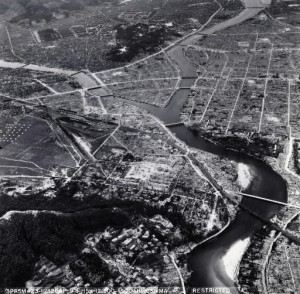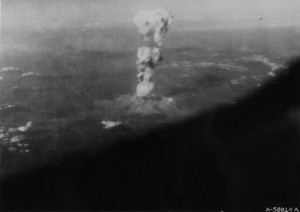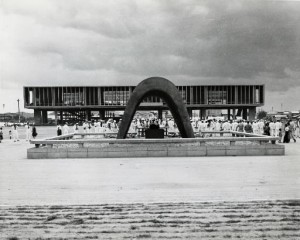Hiroshima Peace Memorial Museum obtains 2,100 photos on A-bombing from U.S. institutions
Jan. 25, 2017
by Kyosuke Mizukawa, Staff Writer
On January 24, the Hiroshima Peace Memorial Museum, located in Naka Ward, announced that it had obtained roughly 2,100 photos related to the atomic bombing from the U.S. Library of Congress, the U.S. Naval History and Heritage Command, and the National Museum of the U.S. Air Force. The museum confirmed that these are valuable images that show the damage to the city center taken from the sky and at the time of reconstruction, including photos it did not already possess. These images will be added to the museum’s website.
Two staff members from the Hiroshima museum visited the United States from November 28 to December 8, and examined the photos at the three institutions for the first time. They obtained about 700 images from each facility by scanning the photos and photographing them from up close. It is believed that more than 100 of the images are new to the museum’s collection.
Ten photos were shown to the press on this day. An aerial photo of the area around Hiroshima Station (now part of Minama Ward), which was apparently taken in the first half of September 1945, was photographed from a low altitude, and the swath of complete destruction from collapsed buildings and fire bordered by the Dambara and Ushita districts can be clearly seen. The U.S. military may have taken these photos to assess, in detail, the effects of the atomic bomb.
Another photo, which was taken when sailors from the U.S. Navy visited the Cenotaph for the A-bomb Victims in September 1955, shows the Peace Memorial Museum, which was established on August 24, 1955. Whether or not the sailors visited the museum at that time will be investigated.
Two photos of the A-bomb’s mushroom cloud that were captured from the Enola Gay, the American B-29 bomber that dropped the atomic bomb, were found in the United States, but the image taken from a longer distance was obtained this time. There is also a photo of the ruined city taken from the sky in January 1946 that was signed by the late Paul Tibbets, the captain of the Enola Gay, and others.
A staff member at Hiroshima Peace Memorial Museum said, “Many of the photos show clear detail even when enlarged. We plan to continue examining them and using them to further understand the devastating consequences of the atomic bombing.”
(Originally published on January 25, 2017)
On January 24, the Hiroshima Peace Memorial Museum, located in Naka Ward, announced that it had obtained roughly 2,100 photos related to the atomic bombing from the U.S. Library of Congress, the U.S. Naval History and Heritage Command, and the National Museum of the U.S. Air Force. The museum confirmed that these are valuable images that show the damage to the city center taken from the sky and at the time of reconstruction, including photos it did not already possess. These images will be added to the museum’s website.
Two staff members from the Hiroshima museum visited the United States from November 28 to December 8, and examined the photos at the three institutions for the first time. They obtained about 700 images from each facility by scanning the photos and photographing them from up close. It is believed that more than 100 of the images are new to the museum’s collection.
Ten photos were shown to the press on this day. An aerial photo of the area around Hiroshima Station (now part of Minama Ward), which was apparently taken in the first half of September 1945, was photographed from a low altitude, and the swath of complete destruction from collapsed buildings and fire bordered by the Dambara and Ushita districts can be clearly seen. The U.S. military may have taken these photos to assess, in detail, the effects of the atomic bomb.
Another photo, which was taken when sailors from the U.S. Navy visited the Cenotaph for the A-bomb Victims in September 1955, shows the Peace Memorial Museum, which was established on August 24, 1955. Whether or not the sailors visited the museum at that time will be investigated.
Two photos of the A-bomb’s mushroom cloud that were captured from the Enola Gay, the American B-29 bomber that dropped the atomic bomb, were found in the United States, but the image taken from a longer distance was obtained this time. There is also a photo of the ruined city taken from the sky in January 1946 that was signed by the late Paul Tibbets, the captain of the Enola Gay, and others.
A staff member at Hiroshima Peace Memorial Museum said, “Many of the photos show clear detail even when enlarged. We plan to continue examining them and using them to further understand the devastating consequences of the atomic bombing.”
(Originally published on January 25, 2017)









